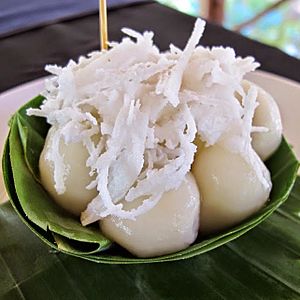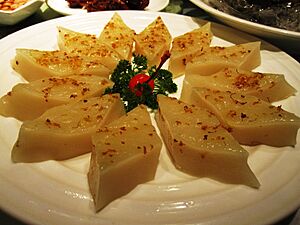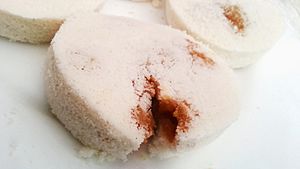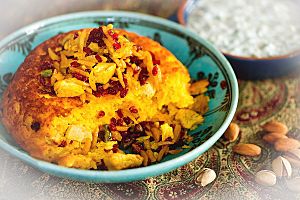Rice cake facts for kids
A rice cake is a food made from rice that has been shaped or pressed into a single piece. You can find many different kinds of rice cakes in cultures all over the world, especially in Asia. They can be made from rice flour, ground rice, or even whole grains of rice pressed together. Sometimes, other ingredients are added to help them stick.
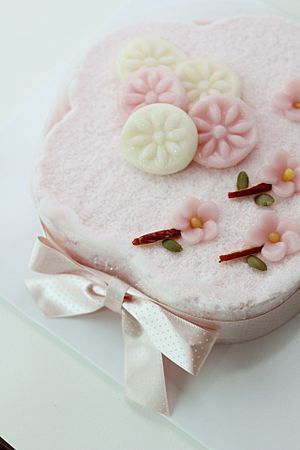
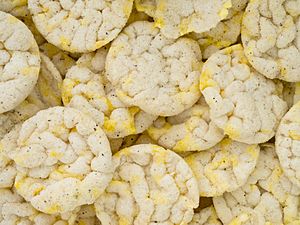
Contents
- Types of Rice Cakes Around the World
- Rice Cakes from Myanmar (Burma)
- Rice Cakes from Cambodia
- Rice Cakes from China
- Rice Cakes from the Philippines
- Rice Cakes from India
- Rice Cakes from Indonesia
- Rice Cakes from Japan
- Rice Cakes from Korea
- Rice Cakes from Sri Lanka
- Rice Cakes from Taiwan
- Rice Cakes from Vietnam
- Rice Cakes in Other Cuisines
- Images for kids
- See also
Types of Rice Cakes Around the World
There are many unique rice cakes in different countries! Let's explore some of them.
Rice Cakes from Myanmar (Burma)
In Burmese cuisine, many snacks and desserts are called mont. These are made with different types of rice, rice flour, or sticky rice flour. Burmese mont are usually not as sweet as similar treats in other parts of Southeast Asia. Their sweetness often comes naturally from ingredients like grated coconut or coconut milk.
Rice Cakes from Cambodia
- Ansom chek is a sticky rice cake wrapped in a banana leaf. It's popular during the Bun Pchum Ben festival, which honors ancestors. It can have a banana filling or pork fat and beans inside.
- Num Kom is a sweet steamed sticky rice flour cake. It's filled with palm sugar, fresh coconut, and roasted sesame seeds. This cake is shaped like a pyramid, representing Buddhist temples.
- Num Krok is a sticky rice cake made from rice flour, coconut milk, and chopped shallots. It's cooked in an iron pan and often dipped in fish and chili sauce.
- Num Plae Ai (ផ្លែអាយ) are sticky rice balls with palm sugar inside. They are rolled in fresh coconut for a tasty coating.
- Num Ah-Kor (នំអាកោរ) is a very popular Cambodian dessert, often served during the Khmer New Year. It's made with rice flour and topped with fresh coconut. It comes in many colors!
- Nom Chak-Kachan is also known as sticky rice layer cake. It's made with sticky rice and tapioca flours, plus coconut milk. It has many colorful layers, with green and yellow being the most common.
Rice Cakes from China


- Chongyang cake is a steamed rice flour cake, often with a bean paste layer inside. It's decorated with fruits like jujubes and chestnuts, and sweet-smelling osmanthus flowers. It's made for the Chongyang Festival.
- Ciba cake is made by pounding sticky rice into a paste. It's often shaped into balls or blocks and usually dipped in brown sugar syrup and roasted soybean flour after being fried or steamed.
- Erkuai (meaning "ear piece") gets its name from its shape. It's usually stir-fried or grilled and wrapped around a fried dough stick called youtiao.
- Fa gao is a steamed, cupcake-like pastry. It's often eaten during the Chinese New Year and is made from rice flour, sugar, and yeast.
- Jian dui (also called Sesame Ball) is a crispy and chewy hollow sticky rice pastry. It's often filled with red bean paste and covered in sesame seeds.
- Ludagun (also called Donkey Roll) is a traditional snack. It's a round sticky rice pastry with honey and red bean paste filling, rolled in yellow soybean flour.
- Nuomici is a sticky rice ball with a sweet filling, dusted with dried coconut flakes.
- Mi gao (rice cake) is made directly from sticky rice, often with dates or red beans. It's steamed and then cut into pieces.
* Zèng gao is a type of Mi gao, originally steamed in an old Chinese cooking pot called a Zèng. It's made with layers of sticky rice, red beans, dates, and raisins.
- Nian gao includes many types, all made from glutinous rice that is pounded or ground into a paste. It can be simply shaped or cooked again.
- Osmanthus cake is a traditional sweet Chinese pastry. It's made with sticky rice flour, honey, sweet-smelling osmanthus flowers, and rock sugar.
- Qingtuan is made from sticky rice mixed with Chinese mugwort or barley grass juice, which gives it a green color. It's usually filled with sweet red or black bean paste. This is a seasonal snack for the Qingming Festival.
- Song gao is a snack from Shanghai. It's made of rice flour, sugar, and water, with azuki beans mixed throughout.
- Tangyuan is made by mixing sticky rice flour with water to form balls. These are then cooked and served in boiling water.
- White sugar sponge cake is a steamed rice cake, usually eaten in square or triangle pieces.
Rice Cakes from the Philippines


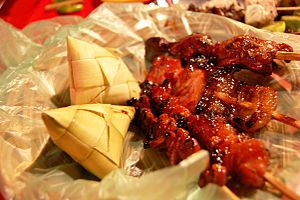
Rice cakes are very popular snacks in the Philippines! Many different kinds exist. In Filipino, most rice-based desserts are called kakanin. This word comes from kanin, meaning "prepared rice."
There are two main types of Filipino rice cakes:
- Puto are steamed rice cakes.
- Bibingka are baked rice cakes.
Both are usually made using galapong, which is a thick rice paste. This paste comes from grinding uncooked glutinous rice that has been soaked overnight.
Here are some examples of traditional Filipino dessert rice cakes:
- Ampaw is a sweet puffed rice cake. It's made from sun-dried leftover cooked white rice that is fried and coated with syrup.
- Baye baye is a rice cake made from coconut and ground green rice (pinipig) or ground corn.
- Bibingka is made with galapong and coconut milk. It's traditionally baked in special clay ovens over charcoal.
- Biko, also called sinukmani, is a rice cake made from coconut milk, sugar, and whole sticky rice grains.
- Espasol is made from rice flour cooked in coconut milk and sweetened coconut strips. It's dusted with toasted rice flour.
- Kutsinta is a steamed rice cake (puto) made with rice flour, brown sugar, and lye. It's served with fresh grated coconut.
- Palitaw is a boiled rice cake disk covered with fresh grated coconut and sugar.
- Puto is a general term for steamed rice cakes, with many different kinds across the country.
- Puto bumbong is a steamed rice cake cooked in bamboo tubes. It has a unique deep purple color.
- Sapin-sapin is made from sticky rice flour, coconut milk, and sugar. It has a distinct layered look because of food coloring.
- Suman is made from sticky rice cooked in coconut milk, often steamed in banana leaves.
Some Filipino rice cakes can be savory. For example, Putong bigas (a common puto) is often eaten with dinuguan, a savory pig's blood stew. Bibingka galapong can also have meat or eggs on top.
There are also non-dessert rice cakes eaten with savory meals, like puso.
- Puso is a common type of rice cake made from sticky rice cooked inside woven pouches of different designs. These pouches are made by weaving leaves into complex patterns.
Rice Cakes from India

- Patoleo are sweet rice cakes steamed in turmeric leaves. They have a filling of coconut and palm jaggery. These are made by the Konkani people during festivals.
- Pitha, in Bengali, Assamese, and Oriya cooking, is usually a thin, flat cake. It's made from a batter of soaked and ground rice. They can be cooked on a griddle, fried, roasted, or baked. Special pithas are made for festivals like Nabanna and Bihu.
- Idli is popular in South Indian cuisine. These cakes are usually small and made by steaming a batter that has been fermented overnight. The batter contains black lentils and rice. Idli is usually eaten with coconut chutney or sambhar, a lentil soup.
- Puttu in South Indian cooking consists of firm cylinders of steamed ground rice with layers of coconut.
Rice Cakes from Indonesia
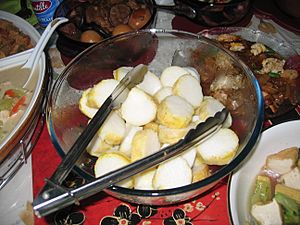
Rice Cakes as a Main Food
In Indonesia, some plain rice cakes are eaten as a main food, like an alternative to steamed rice.
- Burasa is a type of rice dumpling cooked with coconut milk and packed in a banana leaf pouch. It's a special food of the Bugis and Makassar people and is often eaten instead of steamed rice.
- Ketupat, or packed rice, is a rice dumpling from Indonesia. It's also found in Brunei, Malaysia, and Singapore. It's made from rice wrapped in a Rhombus or kite-shaped woven palm leaf pouch and boiled. As the rice cooks, it expands and becomes compressed, giving ketupat its unique shape and texture. Ketupat is often eaten with rendang or served with satay.
- Lontong, popular in Indonesia and Malaysia, is made of compressed rice cut into small cakes. It's traditionally made by boiling rice until it's partly cooked, then packing it tightly into a rolled-up banana leaf. The leaf is secured and cooked in boiling water. Once cooled, it's cut into bite-sized pieces. It's usually served cold with dishes like gado-gado.
Rice Cakes as Snacks
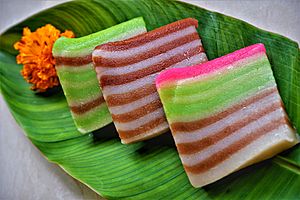
Many types of Indonesian kue (traditional cakes) are made using glutinous rice or rice flour. They can be sweet or savory.
- Arem-arem is a smaller lontong filled with vegetables and meat.
- Klepon are balls of sticky rice flour filled with palm sugar. They are boiled or steamed and then rolled in grated coconut.
- Kue lapis is a colorful layered cake made of sticky rice flour, coconut, and sugar.
- Lemper is a savory snack made of sticky rice filled with chicken, fish, or abon (meat floss). The filling is rolled inside the rice, similar to Chinese zongzi.
- Lupis is compressed sticky rice served with grated coconut and coconut sugar syrup.
- Nagasari is a traditional steamed cake made from rice flour, coconut milk, and sugar, filled with banana slices.
- Putu is a green, pandan-colored rice flour cake filled with coconut sugar and steamed in bamboo cylinders.
- Serabi is a type of pancake made from rice flour with coconut milk.
Rice Cakes from Japan
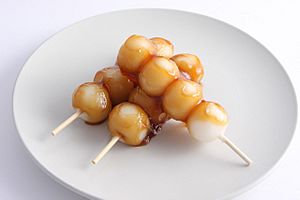
- Mochi is made from sticky rice pounded into a paste and shaped. In Japan, it's traditionally made in a ceremony called mochitsuki. Mochi is a traditional food for the Japanese New Year.
- Senbei are a type of Japanese rice cracker. They are usually baked or grilled, often over charcoal. While cooking, they might be brushed with a flavoring sauce, like one made of soy sauce and mirin. They can also be wrapped with nori (seaweed) or flavored with salt.
- Dango are dumplings made from rice flour. They are often served on a skewer and come in many different flavors, traditionally eaten during different seasons.
Rice Cakes from Korea
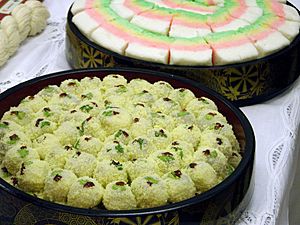
Steamed rice cakes were one of the oldest main foods for Koreans. Today, there are hundreds of different kinds of Korean rice cake, called "tteok," eaten all year round. In Korea, it's a tradition to eat tteok guk (tteok soup) on New Year's Day and sweet tteok at weddings and birthdays. Rice cakes are often seen as a food for celebrations. Their color and role in Korea's traditional beliefs (yin-yang cosmology) can decide when they are eaten.
- Tteok is a general name for Korean cakes mostly made with sticky rice flour (also called sweet rice or chapssal). Tteok is usually divided into four groups: "Steamed tteok," "Pounded tteok," "Boiled tteok," and "Pan-fried tteok."
- Sirutteok is a steamed tteok made from rice or glutinous rice. Sometimes other grains, beans, or sesame seeds are mixed in. Fruits and nuts are also used.
- Injeolmi is an example of pounded tteok. It's traditionally made by pounding rice with special tools. Injeolmi is tteok coated with bean powder. Other pounded tteok include garaetteok (cylinder-shaped white tteok) and jeolpyeon (patterned tteok).
- Songpyeon and Bupyeon are rice cakes that have been molded into shapes. Many kinds of these cakes exist in Korea. Some have sticky rice flour dough and a sweet filling, covered with gomul (a type of powdered beans).
- Kkultteok (meaning "honey tteok") is made by mixing honey with sticky rice powder. It's similar to songpyeon in shape but smaller.
- Hwajeon are small sweet pancakes made of sticky rice flour and flower petals from seasonal blooms, like azaleas or chrysanthemums.
- Tteokbokki is a stir-fried dish made with garaetteok (cylinder-shaped rice cakes). It's commonly sold by street vendors. It's usually seasoned with gochujang (chili paste) and can also have fish cake, boiled eggs, and green onion.
- Tteokguk is a soup eaten during Seollal. It contains sliced tteok, anchovies, green onion, and eggs.
- Mujigae-tteok or 'rainbow rice cake' is a layered tteok with different colors, like a rainbow. The colors are usually light red, yellow, and green.
Rice Cakes from Sri Lanka
- Idli, originally from South India, is a savory rice cake often eaten for breakfast.
- Puttu, also from South India, is widely eaten in Sri Lanka. It's a cylinder made of steamed ground rice and coconut.
- Seenakku, a rice cake made from glutinous rice and served with grated coconut, comes from the Chinese nian gao.
Rice Cakes from Taiwan
- Tainan bowl rice cake (óaⁿ-kóe) comes from the city of Tainan in southern Taiwan. This dish is made by steaming sticky rice once, adding toppings, and then steaming it again.
Rice Cakes from Vietnam
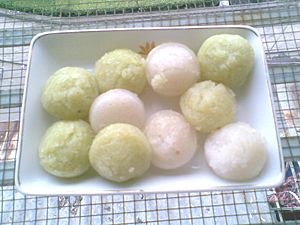
- Bánh bèo is a small steamed rice cake or pancake with a dimple in the center. This dimple is filled with savory ingredients like dried shrimp, scallions, and fish sauce.
- Bánh bò is a sweet, chewy sponge cake made from rice flour, water, sugar, and yeast.
- Bánh đúc is a cake made from non-sticky rice flour. In northern Vietnam, it's usually topped with savory ingredients like ground pork and fried onions. In the south, it's a dessert, often green from pandan leaf extract, and served as jelly-like blocks.
- Bánh chưng is made from sticky rice, mung bean, pork, and other ingredients. Bánh tét is similar but round, and both are eaten to celebrate the Vietnamese holiday Tết.
- Bánh tổ is a rice cake made from glutinous rice and is related to the Chinese nian gao.
Rice Cakes in Other Cuisines
- Chwee kueh (meaning "water rice cake") is a steamed rice cake from Singapore and Johor. It's made by mixing rice flour and water, then steaming it in small cup-shaped containers. The rice cakes are topped with diced preserved radish and served with chili sauce.
- Puffed rice cakes, popular in North America and other Western countries, are made from puffed rice. Puffed rice is created by heating rice kernels under high pressure with steam. The puffed grains are then pressed together to form a cake. These are popular as a lower-calorie choice instead of bread or crackers. They can be plain, salted, flavored, or coated in chocolate or yogurt.
- Rijsttaart and Rijstevlaai in Dutch and Belgian cooking are types of rice pie. They have a filling of mixed rice, sugar, eggs, and milk.
- In Italian cuisine, especially in Tuscany, torte di riso are rice cakes sometimes eaten as a filling dessert.
- In Iranian cuisine, Tahchin or Persian baked rice cake is a steamed rice cake made with yogurt, saffron, eggs, and chicken.
- In Nigerian Cuisine, Masa is a rice cake similar to a pan-fried rice cake, often oval-shaped. It's eaten with different stews and comes from the Hausa ethnic group in the Northern Region.
- Vitumbua is an East African Swahili dish made of rice or rice flour and coconut. It's mostly eaten for breakfast.
Images for kids
-
Idli, a savory cake from South India
-
Lontong, popular in Indonesia and Malaysia, made of compressed rice rolled into a banana leaf
-
Kue lapis, a multi-layered colorful sweet sticky rice cake
-
Dango, a Japanese dumpling made from rice-flour
-
Tteok, Korean rice cakes
-
Steamed Bánh bò, a sweet, chewy Vietnamese sponge cake made from rice flour
-
Bangladeshi style rice cake, originally known as Bhapa Pitha, eaten with molasses as a sweetener
-
Tahchin or Persian baked Saffron rice cake. Decorated with Barberries, Almond and Pistachio slices
See also
 In Spanish: Pastel de arroz para niños
In Spanish: Pastel de arroz para niños


